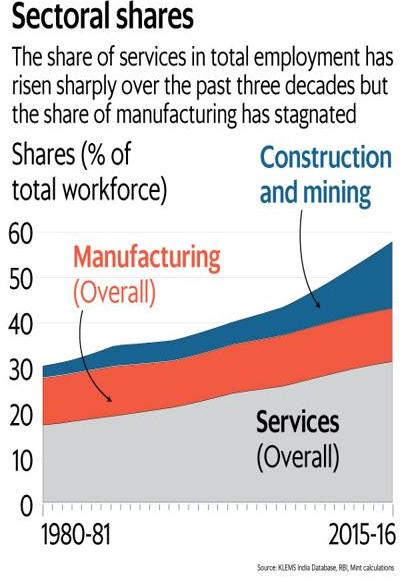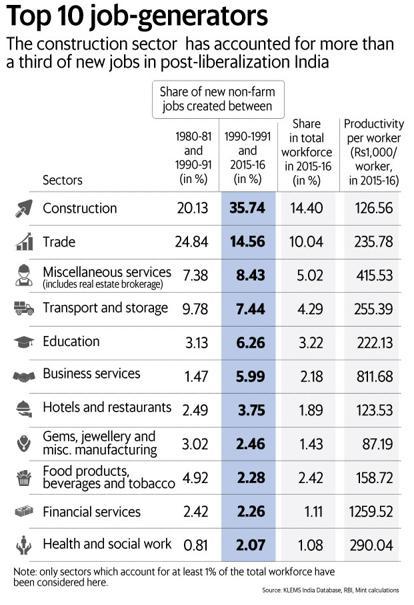
Syllabus (Paper VII): Availability of Skilled Human Resources, Employability and Productivity of Human Resources, Various Trends of Employment.
People are a nation’s greatest resource. Nature’s bounty becomes significant only when people find it useful. It is people with their demands and abilities that turn them into ‘resources’. Hence, human resource is the ultimate resource. Healthy, educated and motivated people develop resources as per their requirements. Human resources like other resources are not equally distributed over the world. They differ in their educational levels, age and sex. Their numbers and characteristics also keep changing.
The Government of India has a Ministry of Human Resource Development. The Ministry was created in 1985 with an aim to improve people’s skills. This just shows how important people are as a resource for the country.
Availability of Skilled Human Resources
Importance of Skilled Human Resources:
- It carries out the development works by utilizing the natural resources effectively.
- It helps in sustainable use of available resources to fulfill the needs of the country.
- It helps to improve the living standards of the people by creating employment and other opportunities to excel in life.
- It develops the capital formation in the country necessary for the overall development of the economy and society.
Availability of Skilled Human Resources:
- Demographic Dividend:
- It is the economic growth potential which arises out of a changing population age structure with a large section of people in the working age group (15-64 years) as compared to the non-working age population (below 14 years and above 65 years of age).
- About 64.4 % of India’s population is in the age group of 15 to 59 years, in 2015. Urban areas account for 67.7 % of the working-age population while rural areas account for 62.9 %.
- According to the data from OECD, the median age of many countries of the world is rising, with 35 years for China, 40 years for OECD countries, and 47 years for Japan, while that of India is just 27.3 years.
- Formal employment in India is heavily reliant on medium-skilled occupations. These include clerical, service and sales workers, skilled agricultural and trade workers and plant machinists. Nearly 60% workers are employed in this skill level, according to ILO data.
- Over 20% are employed in high-skilled jobs as managers, professionals and technicians.
- The rest are elementary occupations like cleaners, labourers and so on. The below chart shows the distribution of workers across skill levels.
Shortage of Skilled Human Resources in India:
- Indian education system is traditional in nature and is not based on skill or career prospects.
- Due to lack of career prospects in India, a major portion of labour migrates to abroad.
- Vocational education is extremely expensive and people can’t afford it.
- There are still very few employment opportunities and a majority of labour is forced to engage in unskilled jobs including disguised employment in agriculture.
Employability and Productivity of Human Resources
As compared to other developed and developing countries, India has a unique window of opportunity for another 20-25 years called the “demographic advantage”. If India is able to skill its people with the requisite life skills, job skills or entrepreneurial skills in the years to come the demographic advantage can be converted into the dividend wherein those entering labour market or are already in the labour market contribute productively to economic growth both within and outside the country.
Skill Development for Employability and Productivity:
- Skill development is an important driver to address poverty reduction by improving employability, productivity and helping sustainable enterprise development and inclusive growth. It facilitates a cycle of high productivity, increased employment opportunities, income growth and development.
- However, this is just one factor among many affecting the productivity whose measurement differs for individuals, enterprise and economy. The increase in productivity can be attributed to varied reasons such as new technology, new machines, better management practices; investment in plant and equipment and technology, occupation safety improvement in the skill level of workers; macroeconomic policies, labour market conditions, business environment and public investment in infrastructure and education.
- Therefore skill development needs to be an integral part of the development policies. The policies should address the levels of development and need and requirement of various sectors. Besides this the skill policy should focus on improving access, quality and relevance of training for different segments and sectors. The evidence from developed countries suggests that investment in education and skills helps economy to move to high growth sectors and break the low wage, low skill development syndrome.
Skill Development linkage to Employability and Productivity:
- The linking of skills and productivity would not only benefit the enterprise and economy but would also facilitate different segments of the population particularly the marginalized sections of the society to reap the benefits of the economic growth through skill development.
- The National Skill Policy provides a framework to ensure access to various target groups to realise their potential for productive work and contribute in economic and social development.
- The National Skill Development policy provides for integration of skill development into the national development polices such as developing infrastructure, reducing poverty and de-cent work agenda.
Challenges for low Employability and Productivity:
- Poor human capital formation:
- Reflected in low employability among India’s graduates and postgraduates.
- According to ASSOCHAM, only 7 % of MBA graduates have employable skills in India, and only around 20-30 % of engineers find a job suited to their skills.
- Low human development:
- Reflected in the human development report of UNDP. According to the Human Development Index of 2018, India stood at 130 out of 189 countries.
- Life expectancy at birth in India (68.3 years) is much lower than other developing countries (Sri Lanka – 75 years, China – 76 years).
- The mean years of schooling and the expected years of schooling are still low at 6.3 years and 11.7 years respectively.
- Jobless growth:
- India’s high growth rate phase (2004-05 to 2010-11) has created significantly fewer jobs as compared to previous decades of economic growth.
- Unemployment rates in rural and urban India are at 4.59 % and 5.47 % in 2017, according to a study by Bombay Stock Exchange.
- Around 47 % of India’s population is still dependent on agriculture which is notorious for underemployment and disguised unemployment.
- Majority of the workforce is employed by the unorganized sector where workers are underpaid and lack any kind of social security.
- Falling female labour force participation:
- According to data from International Labour Organization and World Bank, India’s female labour force participation rates have fallen from 34.8 % in 1990 to 27 % in 2013.
- According to HDI 2018, Female participation in the labour market is 27.2 per cent compared to 78.8 for men. Socio-cultural factors and rising family incomes have been identified as the main reasons for this decline.
Way forward for increasing Employability and Productivity:
- Improving the Education level of the Labour
Force:
- The universalization of elementary education has improved the enrolment and the retention up to the upper primary level. However, there is sharp dropout after that. There is need to universalize the secondary education so that young boys and girls are prepared for working productively in agriculture or to access alternative employment opportunities.
- Improving access to quality training for
employment opportunities:
- In the India context this is very important as the large pool of the demographic advantage resides in the rural areas.
- This may require increase in the training capacities for relevant and high-quality skills, and also require responding to rapidly changing skills needs; upgrading informal apprenticeship systems i.e Apprenticeship Protsahan Yojana so as to deliver skills and knowledge for value added activities and more advanced technologies.
- Coordination among Various Stakeholders:
- This would achieve not only the objective of policy coherence but also address issues of skill gaps, boost productivity, improve employment growth etc.
- The programmes like Make in India, Digital India, Housing for All and Swatch Bharat together with favourable polices for infrastructural development, lower interest rates would offer huge employment opportunities supported by National Skill Mission.
- Strengthening Skill Delivery Framework:
- Most training is implemented at the State level. However, the implementation varies across States with many demographically advantageous States facing not only shortage of physical infrastructure but also quality training.
- For effective outreach and access by different segments of the population, it is necessary to have decentralized implementation at State, district and block level and also to ensure effective coordination and monitoring of skill development initiatives.
- The inter-linkage of the SSDMs with the industry, training providers, Sector Skill Councils, NSDA should be maintained at the policy formulation and implementation level.
- Focus on Outcome and determining key
performance indicators:
- Today focus is on number metrics with minimal or no tracking of the students trained and placed.
- Strengthening Private sector participation:
- There is urgent need to incentivize industry to be to either set up training institutions in PPP mode in industry clusters to facilitate availability of trained manpower for big and MSME units or to adopt existing government ITIs and Polytechnics.
- Further the local industry can be actively involved for curriculum development, provision of equipments, training of trainers, opening incubation centres particularly in the rural areas.
Various Trends of Employment
Informal Sector:
- Till 2004-05 India witnessed predominance of self-employment and increase in the share of the casual category of workers (except for urban females). The latter was generally referred to as increasing ‘Casualization’ of workforce.
- NSS results reveal that the trend of increasing Casualization continued from 2004-05 to 2009-10 across all the sections. However the trend seems to have arrested during 2009-10 to 2011-12 as the share of casual labour declined significantly in all categories whereas that of regular wages/salaried employees increased significantly.
- In rural areas, most of the shift was from agriculture
to non-agricultural activities, such as construction, trade and services.
- To some extent, it was distress-driven, the small and marginal landholders and the landless not finding gainful work in agriculture and taking up whatever work they find in the non-agricultural activities, irrespective of earnings from them.
- But there is evidence to suggest that many were opting for non-farm work due to more regular employment and better earnings.
- About 84 per cent of workers are in the ‘unorganized’
or ‘informal’ sector and more than 90 per cent in informal employment
(taking formal and informal sectors together).
- Preponderance of the workforce in the informal sector with symptoms of informality such as deprived job- security, tenurial security, guard against arbitrary dismissal, safety in work-profile, social security benefits etc calls for putting adequate safety measures for workers in place but according to some the rigidity of many of these regulations are to be blamed for poor organised employment
Organised Sector:
- In aggregate, growth rate of employment in the organised sector initially registered a continuous decline from 1972-73 to 2004-05 (as per NSS Reports) followed by a reversal i.e increasing growth since 2005-06.
- The share of private sector increased from about 31 per cent to about 38 per cent during 2000-2010 decade.
Sectoral Distribution of Employment:



 Home
Home Syllabus
Syllabus Contact Us
Contact Us




